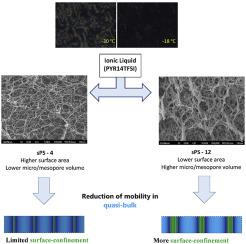Polymer ( IF 4.6 ) Pub Date : 2020-09-28 , DOI: 10.1016/j.polymer.2020.123081 Prasad Raut , Shichen Yuan , Toshikazu Miyoshi , Sadhan C. Jana

|
In this work, ionogels fabricated by incorporating room temperature ionic liquids (ILs) in meso- and macroporous syndiotactic polystyrene (sPS) gels, are studied by using differential scanning calorimetry (DSC), polarized optical microscopy (POM), rheology, and nuclear magnetic resonance (NMR) spectroscopy. sPS gel network is prepared via thermo-reversible gelation in tetrahydrofuran and the pores are subsequently filled with the ionic liquid, 1-butyl-1-methylpyrrolidinium bis(trifluoromethylsulfonyl)imide (PYR14TFSI). Using DSC and POM it is found that PYR14TFSI molecules in sPS gels show higher melting temperatures than that for the neat PYR14TFSI. 1H static NMR signals provide overall mobility of ILs in the sPS gels. Surprisingly, the ionogel prepared with 0.04 g/mL sPS solution apparently shows the broadest 1H NMR signals among the gels prepared with 0.04, 0.08, and 0.12 g/mL sPS concentration. This is attributed to a quasi-bulk state of ILs. Moreover, two-dimensional 1H NOESY spectra indicate that PYR14TFSI molecules in sPS show strong non-bonded through-space correlation peaks and their intensities increase proportionally with polymer concentration in the gel, while such correlation peaks are not observed for the neat PYR14TFSI molecules. The observed concentration dependence of constrained PYR14TFSI dynamics is interpreted in terms of the confined PYR14TFSI at the surface or closer to the surface of sPS scaffold. From these experimental results, it is suggested that PYR14TFSI melting-temperature are more related to quasi-bulk component than the constrained PYR14TFSI in the sPS gels.
中文翻译:

表面积和孔隙率对介孔和大孔聚合物网络中IL分子行为的影响
在这项工作中,通过使用差示扫描量热法(DSC),偏振光学显微镜(POM),流变学和核磁研究了通过将室温离子液体(ILs)掺入介孔和大孔间同聚苯乙烯(sPS)凝胶中制备的离子凝胶。共振(NMR)光谱。通过在四氢呋喃中进行热可逆凝胶化来制备sPS凝胶网络,然后用离子液体1-丁基-1-甲基吡咯烷鎓双(三氟甲基磺酰基)酰亚胺(PYR14TFSI)填充孔。使用DSC和POM,发现sPS凝胶中的PYR14TFSI分子显示出比纯PYR14TFSI更高的熔化温度。1个H静态NMR信号提供sPS凝胶中IL的整体迁移性。出人意料的是,用0.04 g / mL sPS溶液制备的离子凝胶显然显示了在以0.04、0.08和0.12 g / mL sPS浓度制备的凝胶中最宽的1 H NMR信号。这归因于IL的准批量状态。而且,二维1H NOESY光谱表明,sPS中的PYR14TFSI分子显示出很强的未键合贯穿空间相关峰,并且其强度随凝胶中聚合物浓度成比例增加,而对于纯PYR14TFSI分子则未观察到此类相关峰。观察到的受约束的PYR14TFSI动力学的浓度依赖性是根据sPS支架表面或更靠近表面的受约束的PYR14TFSI来解释的。从这些实验结果表明,与sPS凝胶中受约束的PYR14TFSI相比,PYR14TFSI的熔融温度与准本体组分更相关。



























 京公网安备 11010802027423号
京公网安备 11010802027423号